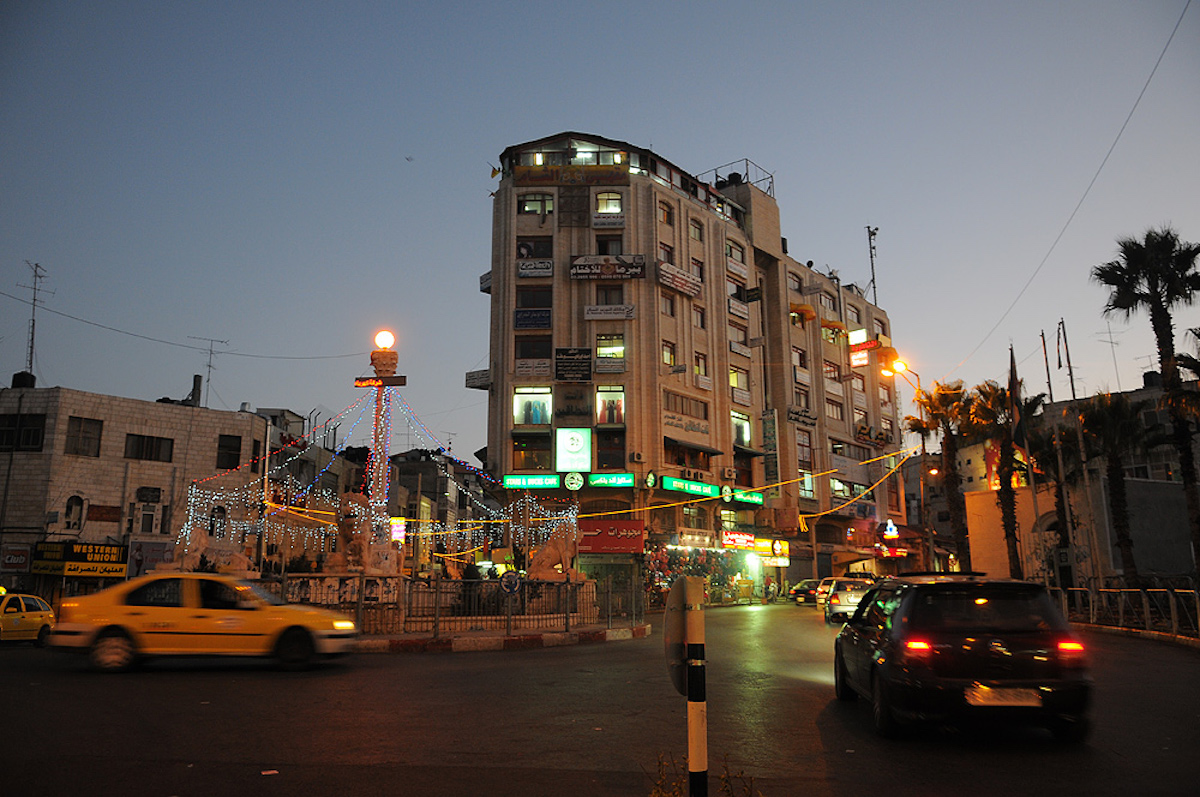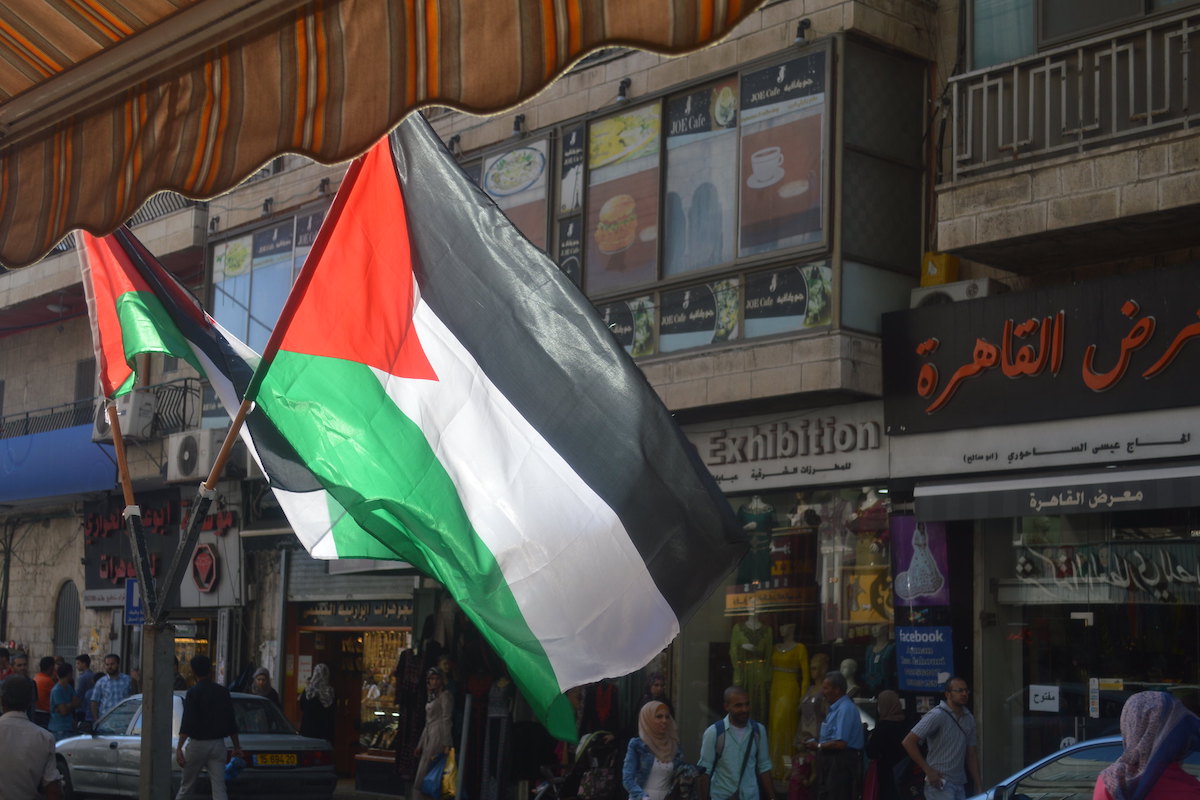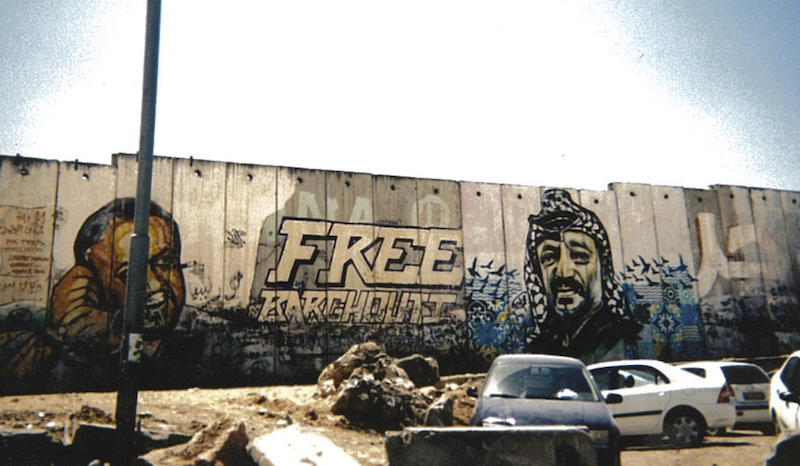Ramallah For Beginners
Many of the most renowned symbols that unify Palestinians are connected to political revolutionaries.

It’s Saturday evening, and we’ve crossed over to the Palestinian side of the Green Line. I’d always thought that entering the West Bank would be difficult, but it’s not. There are no security officers to ask you questions, no passports to show, no gates to be lifted; just an unobstructed road. Upon leaving Israel, the navigation app Waze displays a red box containing the words “high-risk area” at the top of the screen. (Of course, crossing back the other way is much more difficult.)
As we go deeper into the West Bank, I grow tense, though there aren’t any apparent threats. After twenty minutes, we drive past a settlement where the entrance is guarded by Israeli soldiers peering out of concrete bunkers. One of them is a young woman. The barrel of her rifle rests on a pile of sandbags. She seems be looking through her scope at every passing car. I’m told that these guards don’t discriminate between Israeli and Palestinian license plates, because some attackers have used Israeli cars.
The actual geography of the West Bank, by contrast, invites a sense of freedom and lightness. On the Israeli side, the terrain had been full of military construction: concrete compounds, barbed-wire fences and sniper towers. But here in the West Bank, there’s little sign of industry: The landscape opens up, and the work of the architect and engineer gives way to a harsh beauty. The horizon becomes visible, as do the olive trees, the only obvious greenery covering the yellow hills. From the highway, I can see farmers on donkey-back treading the dirt paths between the groves. Paradoxically, the West Bank feels more biblical than Jerusalem itself.
Over the past two weeks, my Canadian friend Ari and I have been travelling to the West Bank and back by rental car. I’m 26 and unemployed, so I opted for the cheapest vehicle available—a Nissan Micra, which also turns out to be a favorite of Israeli Settlers. Because Ari is Jewish and I’m not visibly Arab, we don’t exactly blend into the local Palestinian traffic. Since we don’t want people to think we’re settlers, we’ve hung Islamic prayer beads from the rear-view mirror, and placed a Keffiyeh, the black-and-white scarf symbolic of Palestinian opposition to Israel, on the dashboard. Our windows are kept half-down so that the Arabic music we’re playing can be heard. While driving through villages, we’re told, it’s best to look bored while driving aggressively. If someone is staring, we make eye contact but do not hold it. You’re also supposed to smoke—constantly—as many Palestinian men do.

Tonight, we’re headed to Ramallah, the capital of the Palestinian Authority. We’re joined by one of Ari’s friends, Hiba, who’s told us she’d introduce us to some of her Palestinian friends. On the way, we pass through the village of Qalandia, recognizable from the oft-displayed images of the nearby border wall separating the West Bank from Israel. A frequent site of Palestinian protests, it’s covered in black soot from the burning tires rolled into it. The Palestinian side displays two iconic spray-painted portraits. One is Marwan Barghouti, a leader of the First and Second Intifada, who’s been imprisoned in Israel since 2002. He’s depicted holding a phone with two hands to his right ear, eyes directed diagonally upwards, as though about to issue a command. The other, more immediately recognizable portrait, is of Yasser Arafat (1929-2004), the first President of the Palestinian National Authority and Chairman of the Palestinian Liberation Organization. He’s shown with his Keffiyeh neatly crowning his head, curtaining his neck from behind, and draping down his right shoulder. (Before Arafat turned the Keffiyeh into a national symbol, the scarves were worn by Palestinian farmers to protect their heads from the sun.) Between the two portraits are the words “Free Barghouti,” written in English capital letters.

It’s 9 PM, and the streets of Qalandia are jammed with cars honking and people yelling. In two days, it will be Ramadan. The main road, on which we find ourselves, is lined with clean, brightly lit stores—though the road itself is littered. A concrete barrier separates the lanes, which people hop over as they cross to the other side.
Then comes a sudden bang that overwhelms the other street noises. Having fired guns in the past, I recognize the sound. Then another thunderous bang.
People come out of shops and look in the direction of the shooting. We all hear a rapid succession of shots—the source being close enough that we can smell the gunpowder. The other cars aren’t stopping or pulling over, so we simply do as they do and continue around the bend—where we see hundreds of men dancing, clad in black suits. It’s a wedding.
“Welcome to Palestine,” Hiba tells me.
It’s the same half-joke I’ve heard from every Arab after a slight scare. If it’s not “Palestine,” it’s the name of the Arab village I happen to be in. “Welcome to our side.”
“Ramallah” translates from Arabic to English as “God’s Hill.” It’s nearly a kilometer above sea level and feels colder than Tel Aviv. (Having stereotypically associated Arabs with warm weather, I left my jacket with the Jews by the Mediterranean shore.) After parking our car, the three of us go straight to a bar and dance club called Berlin”—one of the few places in Ramallah where people can drink openly. It’s in a downtown area surrounded by banks and expensive restaurants. While Ramallah’s Arabs are mostly Muslim, Berlin’s customers seem to be mostly Christian. Yet from what I can tell, religion isn’t an issue once you’re inside.
After taking a shot of Arak, an anise-flavoured spirit that tastes like toothpaste, Ari recognizes a man from an Arab village in Israel where they both work. Usually, the fellow strikes a dignified and pious posture, I’m told. But tonight, he’s dancing on a table, apparently drunk, and smoking a cigar. Much as many outwardly religious Israeli Jews treat Tel Aviv as a hedonistic refuge, some Arab-Israelis come to Ramallah for similar purposes. While Tel Aviv might be closer, the West Bank is cheaper and more welcoming. (I’m also guessing the Muslim drinker prefers to turn his back on God alongside other Muslims: Better to spite only his God, and not his God and his people.)
One strange aspect of life in Ramallah is that the conflict with Israel is emphasized in the way the city markets itself to tourists. The hostel where Ari and I stay is called Area D—a play on the Oslo II Accords, which divided the West Bank into three administrative sections, lettered A through C. The hostel’s website boasts that Area D is “beyond the confines of these actors (Israel and Palestine) and provides a fun and safe space for budget travelers to use a base for exploring the West Bank.”
Of course, Area D does not really lie beyond the “confines” of either authority. Ramallah is officially under Palestinian Authority control—but the Israeli Army sometimes enters to carry out arrests. (The night we checked in, two Palestinian men were taken by Israeli forces from the premises of a mosque down the road.)
The following morning, Ari and I awaken to the Muslim call to prayer—and hangovers. Ari has received a text from his boss, Hosni, an Arab-Israeli who owns a well-known restaurant outside of Tel Aviv. Hosni apparently has many connections on both sides, and has generously provided a taxi and driver, who soon shows up outside our hostel. On his itinerary: the tomb of Arafat, and a museum dedicated to the famous Palestinian poet Mahmoud Darwish (1941-2008). First, however, he wants to bring us to a community square, which turns out to be an ordinary-looking traffic roundabout on the city’s edge.
Then I see why he’s brought us to this place: Surrounded by flowers and elevated a few steps above the sidewalk stands a 20-foot statue of Nelson Mandela. Unveiled in 2016, the statue features a smiling Mandela raising his right hand, clenched into a fist, skyward. Unusually, this statue has been painted. Mandela’s skin is dark brown, and his hair is salt-and-pepper. He’s also dressed in a black suit and white shirt, with a necktie colored in the same red hue as the triangle on the Palestinian flag. We pose for a few selfies with our driver before moving on.
Many of the most renowned symbols that unify Palestinians are connected to political revolutionaries. In addition to Mandela, Arafat and Darwish, Che Guevara is a common figure on T-shirts worn by Palestinian men. The fact Mandela is from Africa and Guevara is from South America isn’t important: Culturally, the Palestinians identify with any sort of political underdog.
Back at the hostel common room, we meet the day’s new visitors—including a group of three British women in their early twenties, who’ve come directly from Ben Gurion airport. Before we can launch into any sort of tourist chit chat, the women tell us solemnly that they’ve come to the West Bank to “get a better understanding of the conflict” and “to see the oppression first-hand.” This is a politically-aware tourist niche that the hostel’s managers market to explicitly. On the lobby walls are signs soliciting visitors who wish to bear witness to suffering. One poster advertises a tour of a nearby refugee camp, Al Am’ari. In fact, this is where the women are headed the next day.
As the day passes, we encounter more visitors. All women, they’ve come from Germany, France, Austria and England. An archetype emerges: visitors touched and troubled by the plight of the Palestinians who’ve traveled here to gain personal insights.
In this latter respect, they’re not too different from me. Their understanding of the Palestinians seems to extend no further than the political identity assigned to them by the global community. Most seem to know a fair bit about the history of the conflict, the number of dead in the most recent conflicts, and the shifting boundaries between Jewish and Arab control. But when it comes to the Palestinian people themselves—how they cook and eat, how they tease and flirt, how they celebrate and mourn—they know even less than I do. Many will no doubt educate themselves during their trip. But it strikes me that, without intending it, most of us have stereotyped the Palestinians as freedom fighter or terrorist—geopolitical character actors within the grand narrative of what is vaguely described as “the Middle East conflict.”
It’s interesting to note the difference between how Arabs behave in Ramallah and Tel Aviv. In Israel, most young Arabs speak Hebrew and few young Jews speak Arabic. The linguistic gap, according to Ari, means that “when Jewish Israelis hear spoken Arabic, which they perceive as screams, they don’t know if a bomb is about to go off or one guy is simply complimenting another guy’s shoes.” He made this comment in a Ramallah café, where several Arab men nodded in agreement.
A few days later, when we were back in Tel Aviv, Ari and I ran into some of those same British women who we’d met at our Ramallah hostel. Ari, seeking to wind them up a little, asked them how they were enjoying “the party capital of the occupiers.”
“I f–king hate to say it, but I love Tel-Aviv,” said one. It almost sounded as if she were confessing to having betrayed her side.

At Nelson Mandela Square, I ask our driver what significance the statue had for the Palestinian people, expecting he’d give me a political answer. But instead, he surprised me. He told me that on Tuesday nights, Ramallah’s wealthier young men would bring their sports cars and motorcycles, and form a line along the sides of the road leading up the statue. Each driver would take his turn driving around the statue, while others would rev their engines and run burnouts. He was happy to add that many beautiful women, wearing tight jeans and who don’t veil their heads, would come to watch the spectacle.
While I had been hoping for a story about the misery of his situation, he told me what I least expected—what he found fun. The honest admission reminded me to step out of my solemn stereotypes. No matter how deep you look into the conflict, whether you blame the Jews, or blame the Arabs, or blame both, this really is just Man’s oldest game: drawing lines in the sand and calling what’s on your side “mine.”












